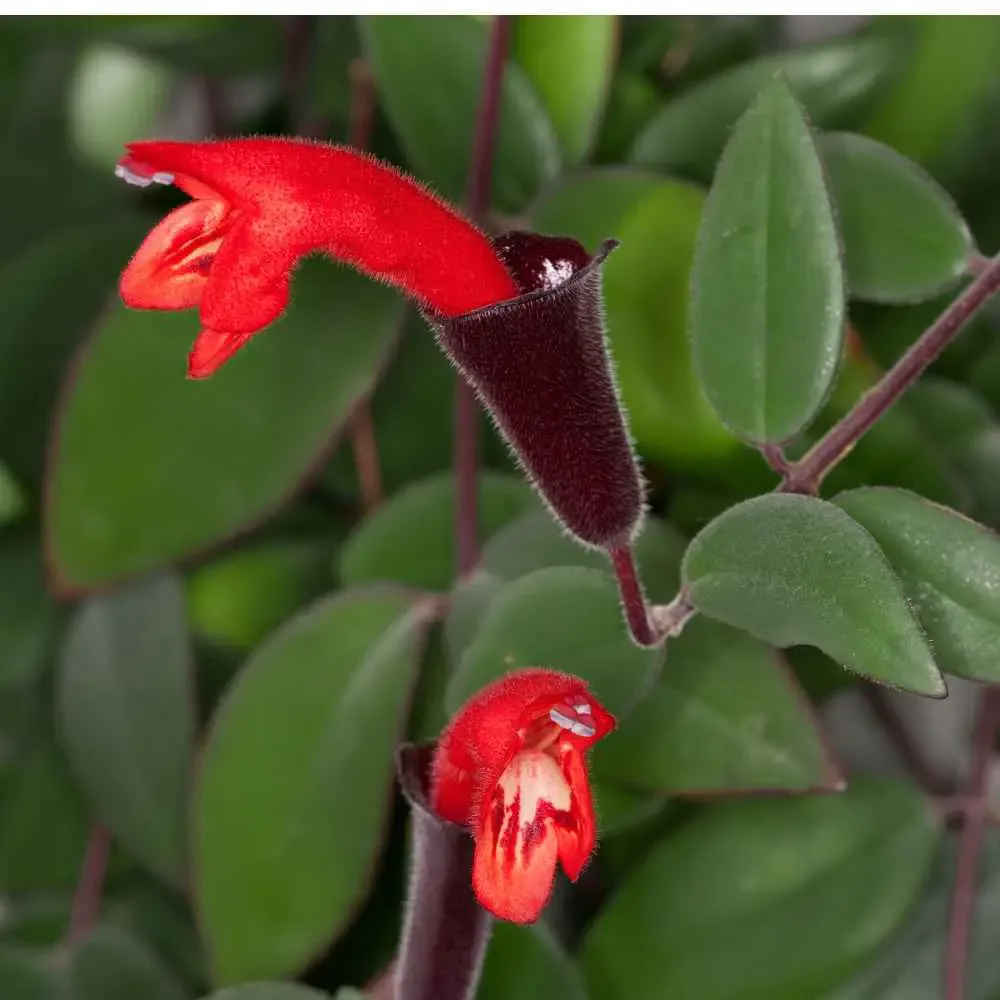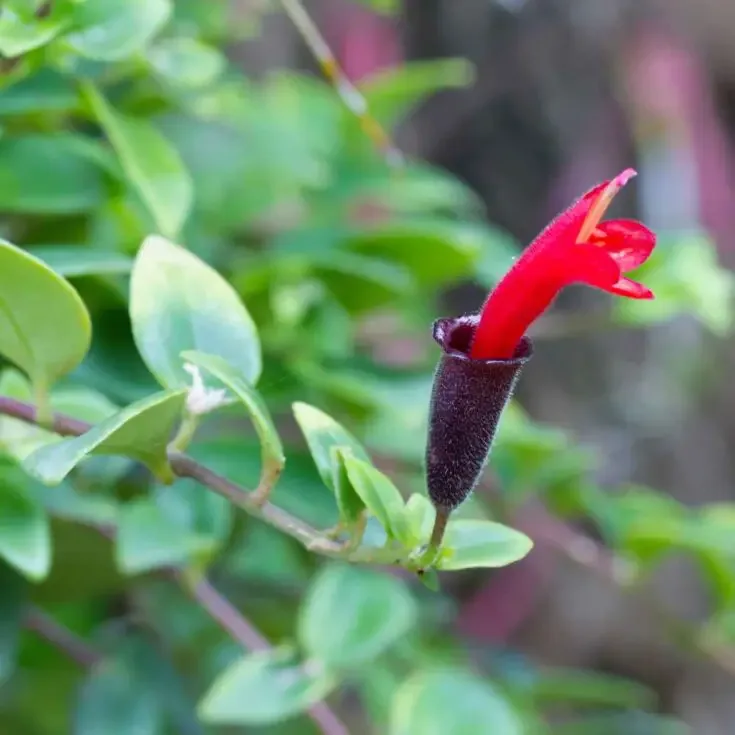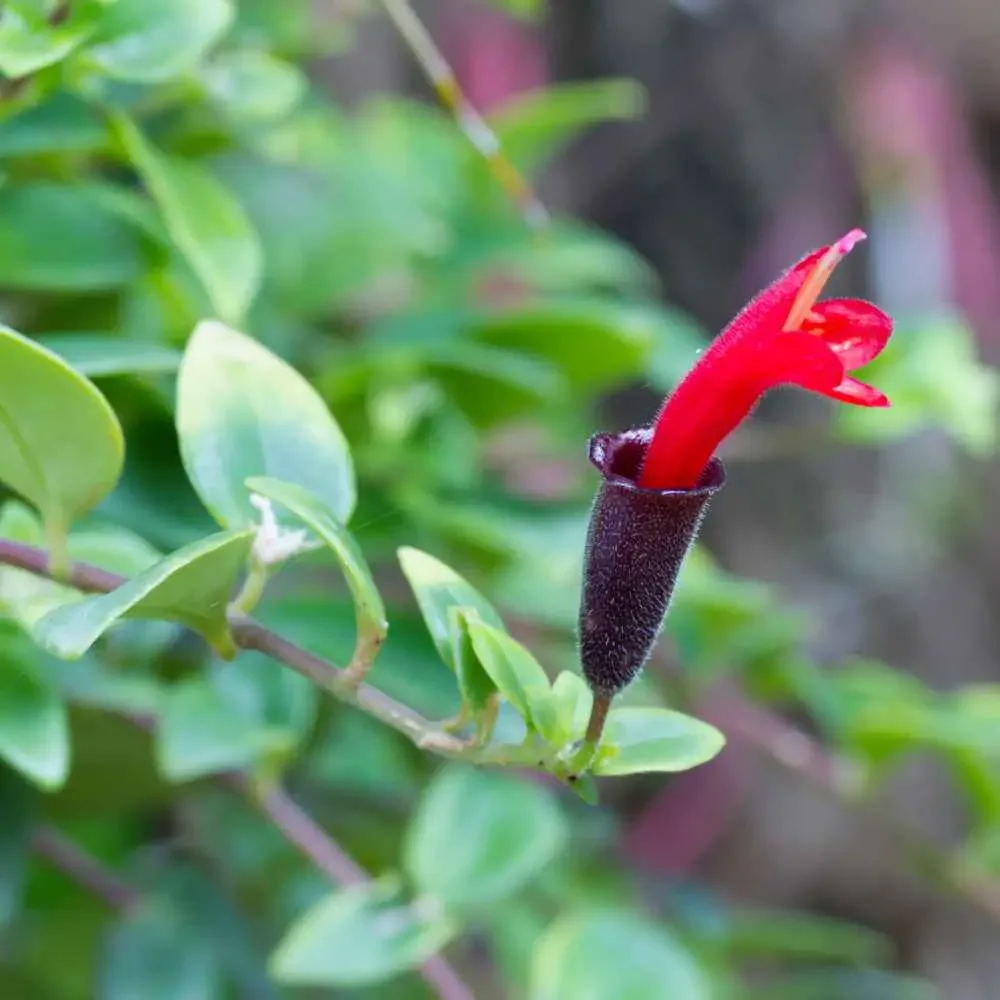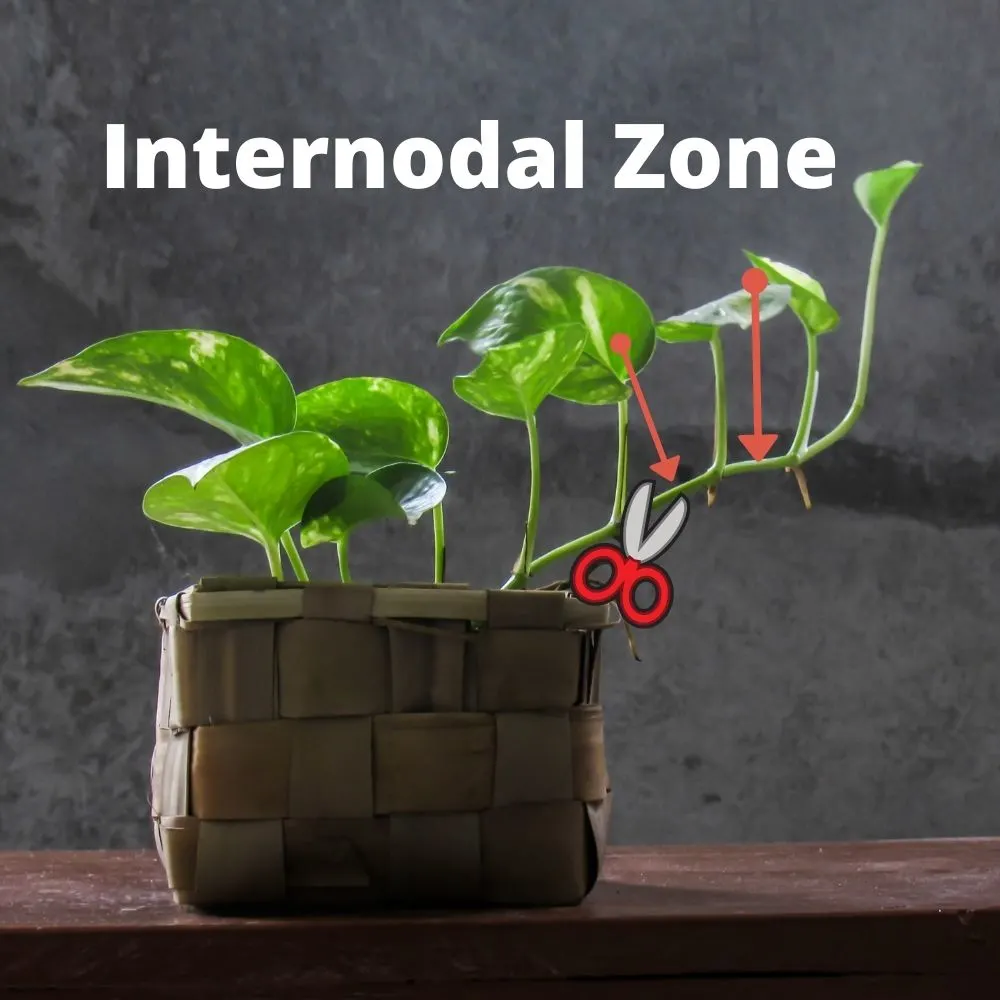The lipstick plant (Aeschynanthus radicans) is a stunning tropical houseplant known for its brightly colored, tube-shaped flowers. The flowers resemble tubes of lipstick emerging from the trailing vines.
The lipstick plant is native to Southeast Asia. It resides in the Gesneriaceae plant family, along with the goldfish plant and African violets.
In nature, the lipstick plant grows as an epiphyte in the rainforest. This vine will attach itself to trees and find the light, food and the moisture it needs to grow without harming it’s host.
Glossy, dark green leaves and vibrant flowers that bloom throughout the year make this an attractive houseplant. It is a great addition to any indoor space where you want a touch of exotic beauty. Aeschynanthus radicans ‘variegata is an attractive variegated lipstick plant with white edges surrounding the green leaves.
With proper care, the lipstick plant can thrive and add a cheerful, bright stunning color and contrasting texture wherever you place it.

Is lipstick plant an indoor plant? Yes, the Lipstick Vine (Aeschynanthus radicans) is primarily grown as an indoor plant. It is well-suited to growing in containers, pots and baskets. This plant thrives in warm, humid environments, and does well grown indoors as a houseplant.
Where do I put my lipstick plant? The Lipstick Vine is relatively easy to care for, when given bright indirect lighting, proper watering, and fertilization, it will thrive in a lot of different indoor environments.
It can also be grown outdoors in warm, humid climates year round or as a patio plant in cooler climates. Give it protection from direct sunlight, strong drafts and pot it in well-draining soil.
Can a Lipstick Plant Live Outside?
The ideal outdoor location for the Lipstick Vine on a patio is a bright, shaded spot with protection from the wind. The plant can be grown in a container or hanging basket with well-draining soil and regular fertilizing and watering.
This is a lovely hanging basket plant to grow outdoors if you have warm weather (over 60 degrees F) and indirect sunlight. Keep this plant away from Strong sunlight, winds and drafts or it will have reddened burned leaves and the vine will look sparse and sick.
Can you plant lipstick vine directly in the ground? You can plant lipstick vines in the garden bed in garden zones 10 and 11. However, be careful. This plant can become invasive and hard to control when planted in ideal conditions. It may take hold and start growing up your trees, along a fence or become a problem weed in your garden beds. Best to plant it in a container or hanging basket for outdoor growing.
Do Lipstick plants attract hummingbirds? The long tubular, bright colored flowers of Aeschynanthus radicans are just perfect for hummingbird beaks. The tiny birds love Lipstick plants.

How Often Does a lipstick Plant Bloom?
The Lipstick Vine (Aeschynanthus radicans) can bloom throughout the year if it is given the right growing conditions. The plant typically produces blooms in cycles, with individual flowers lasting for a few days to a week before falling off. After the blooms have faded, the plant may take a brief break before producing another round of flowers.
With proper care, a healthy Lipstick Vine can bloom several times a year, providing a beautiful display of vibrant red, pink, orange, or yellow tubular flowers. Factors that can affect the plant’s blooming frequency include light, temperature, humidity, and fertilization, so it’s important to provide the plant with optimal growing conditions to encourage regular blooming.
Lipstick Vine Healthy Housemate Properties:
While the Lipstick Vine (Aeschynanthus radicans) is not specifically known for its air-purifying abilities, like other indoor plants (like Pothos), it can help improve indoor air quality.
Plants are known to absorb toxins from the air through their leaves, roots, and soil, and convert them into harmless compounds that are used for their growth.
Plants are very beneficial to people emotionally and as an environmental addition to your home.
Read more about why houseplants are beneficial to people here .
The Contented Plant
Although research on the specific air-purifying abilities of the Lipstick Vine is limited, several studies suggest that plants in the Gesneriaceae family, to which the Lipstick Vine belongs, can remove a variety of common indoor air pollutants, including formaldehyde, benzene, xylene, and toluene.
In addition to its potential air-purifying benefits, the Lipstick Vine can be a healthy housemate in other ways. Like most plants, it produces oxygen as a byproduct of photosynthesis, which can help improve air quality and create a more pleasant living environment.
Plants are also known to have a calming effect on people, and can help reduce stress and improve mood. Finally, caring for plants can be a rewarding and enjoyable hobby that promotes mindfulness and relaxation.
How do you care for Aeschynanthus radicans?
Here’s your ‘At a glance’ Care guide for the lipstick vine. Be sure to read our in depth printable care guide at the bottom of this post for more details on how to take care of your lipstick plant.
| Familiar Names | Lipstick plant, lipstick vine, |
| Scientific Name | Aeschynanthus radicans |
| Plant Family | Gesneriaceae |
| Care Difficulty | Easy care |
| Temperature | Lipstick vine is sensitive to chilly drafts and may lose leaves if exposed to sudden temperature changes. It prefers stable temperatures between 60 to 74 degrees F. |
| Watering | Keep the soil evenly moist using room temperature water. Do not allow the plant to be waterlogged. The pot must drain well. Overwatering can lead to root rot and other fungal diseases, while under watering can cause the plant to wilt and the leaves to drop. |
| Humidity | Ideally, the lipstick plant prefers a humidity level between 50-70%. Use humidifiers, misting, pebble trays and plant grouping to enhance humidity as needed. |
| Soil | Lipstick Vine prefers a slightly acidic soil with good drainage to prevent waterlogging. To ensure that the soil is well-draining, you can mix perlite, sand or vermiculite with the potting soil. |
| Fertilizer | During the growing season fertilize the plant every two weeks using a balanced (10-10-10 or 5-10-5) water-soluble fertilizer diluted to half strength. |
| Lighting | Prefers bright, indirect light to thrive. It can tolerate some direct sunlight during the morning or evening hours, but prolonged exposure to direct sunlight can scorch the leaves and cause damage to the plant. Aeschynanthus radicans ‘variegata will require more light for best colors. If the leaves turn red they may have too much light. |
| Growth Habit | This is a slow growing trailing or climbing plant that can grow up to 3 feet long when mature. Its stems are thin and wiry, and they produce small, oval-shaped leaves that are about 2-3 inches long. The plant produces vibrant, tube-shaped flowers that are typically red or pink, although some cultivars have yellow or orange flowers. |
| Pruning | To encourage bushier growth, you can pinch back the stem tips or prune the plant in the spring or early summer. This will help promote lateral branching and a fuller, more compact shape. This plant can also be trellised on a moss pole or different trellis. |
| Propagation | Propagation through stem cuttings is a simple and effective way to propagate the Lipstick Vine, and it can be done at any time of the year and takes a few weeks in either soil or water. |
| Pet Safe? | Yes, the Lipstick vine is cat safe and dog safe too. |
Lipstick Plant

The Lipstick Vine (Aeschynanthus radicans) is a tropical evergreen vining plant that can grow up to 3 feet in length, with small, glossy green leaves that are about 2 inches long. The plant gets its common name from its striking tubular flowers, which resemble a tube of lipstick and come in shades of red, pink, orange, and yellow.
Materials
Instructions
Lipstick vine Soil Preference:
- This vine requires a light soil.
- A mix of potting soil and perlite will keep the roots happiest.
- Our mix for this pothos is 60 % potting mix to 40% perlite.
- A heavy soil potting mix is not recommended.
Pot Size and Type:
- Lipstick vines can be grown in relatively small pots since they are fairly slow growers.
- Any well drained pot can be used. It MUST have drainage.
- Repot every second year or when roots come out the drainage holes on the pot bottom To the next pot size up.
- Don't jump to a huge pot from a small one unless you wish to encourage faster growth. Just go to the next size up pot.
Lighting Requirenments:
- The lipstick vines enjoy moderate to bright indirect or dappled light.
- Shield this plant from strong direct light in summer south and west sunny windows. The leaves will burn.
- Tip: Window sheers or blinds can offset some brief periods of high direct light.
How to Water Lipstick plant:
- Water your lipstick plant when the soil is dry down an inch or so. Give it a good soak so all the soil is moist. Then let the pot completely drain. Pour out any water in the drain plate.
- Aroids do not like to be overly wet. Try a watering schedule of every other week. But let the plant guide you rather than the calandar.
- This tropical plant enjoys humidity. In dry climates this Plant will thrive with a humidifier nearby. or set it in your kitchen or bathroom. For a really dry climate frequent misting will help.
- In dormant winter months reduce watering to when the soil is dry down halfway .
- Never let this plant get wet feet. If the soil is compacted the bottom of the soil can remain wet which encourages root rot and fungus gnats. If you see yellow leaves on pothos you are probably overwatering.
How to Fertilize :
- Apply a good quality fertilizer (linked in materials) monthly through Spring and summer.
- Decrease feedings by late Fall and allow the vine to rest through the winter months.
- Look for brown spots on the leaves of your plants. This may indicate an over concentration of salts in the roots from over feeding. It can burn the leaves.
- Read Our Post On Fertilizing plants for more information.
Temperature:
- Keep lipstick plant at a low of 60 Degrees F. to upward of 75 Degrees F. It enjoys warmth and humidity and stable temps. Keep this plant away from drafts or severe temperature changes.
Pruning and Training:
- Pruning will give you a fuller plant with more even growth. Unpruned lipstick vine will trail and get leggy.
- Sharp Hand pruners are preferred for pruning. They will give a clean cut that will heal quickly.
- lipstick vine in a basket will trail. In a pot you can keep it trimmed or let it spill off a shelf.
Table Top Plants: 
- It’s easy to prune and shape these plants to whatever length and fullness you desire.
- As a table top plant cut the trailers back evenly all around the pot. If you want the pot fuller add more stem cuttings into the soil..
Pests:
- Lipstick vine is not fussy and resists pests. However all plants can get attacked by pests.
- Stress by longterm overwatering, poor light, extreme temperatures and soil conditions are contributors to plant stress..
- Read Our Post on 7 most common plant pests and how to kill them.mites, mealy bugs, spider mites, scale, thrips and whitefly are the most common houseplant pests you will see.
- Read our post on How to get rid of aphids and other pests with our homemade pesticide soap recipe or neems oil.
- To minimize the possibility of pests be sure to check all nursery plants before bringing them home.
- Quarantine all new plants until you are sure no pests live in them.
How to Propagate:
- You can easily propagate the lipstick vine by stem cuttings in either water or soil. Here's the steps:
- Propagation is easily done through leaf node stem cuttings.
- You need a 3 to 6 inch leaf stem with a couple of nodes and healthy growth.

- Place the node into a jar with water or a plant pot with moist soil. For water propagation- Use tap water that has settled 24 hours in the jar to dissipate chemicals harmful to the neon.
- Set the jar in a well lit area.
- After several weeks roots will grow. Allow the roots to get an inch or more in length.
- Plant gently and firmly into pot with proper soil mix.
- Make sure to keep the soil moist until the roots begin to set into the soil. Be sure to read our post on Propagaing pothos here.
Follow Us:
Find us on YouTube, Instagram , Pinterest and TikTok! We love to Plant chat. We also comment, like and occasionally share your content to our daily stories. We’d love to see your plants. Share your joy in your houseplants. Happy Planting!


